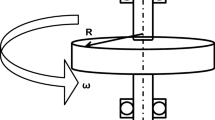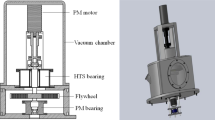Abstract
Flywheel energy storage (FES) can have energy fed in the rotational mass of a flywheel, store it as kinetic energy, and release out upon demand. The superconducting energy storage flywheel comprising of magnetic and superconducting bearings is fit for energy storage on account of its high efficiency, long cycle life, wide operating temperature range and so on. According to the high temperature superconducting (HTS) cooling mode, there are zero field cooling (ZFC) bearings and field cooling (FC) bearings. In practice, the superconducting bearings are formed by field-cooled superconductors and permanent magnets (PMs) generally. With respect to the forces between a permanent magnet and a superconductor, there are axial (thrust) bearings and radial (journal) bearings. Accordingly, there are two main types of high-temperature superconducting energy storage flywheels, and if a system comprising both the thrust bearing and the radial bearing will have the characteristics of both types of bearings. Magnetic force, magnetic stiffness and damping are these three main parameters to describe the levitation characteristics. Arrangement and shape of superconductors, thickness of superconductor, superconducting flux creep and critical current density of the superconductor affect the magnetic levitation force of these superconducting bearings. The key factors of FES technology, such as flywheel material, geometry, length and its support system were described, which directly influence the amount of energy storage and flywheel specific energy. All these results presented in this paper indicate that the superconducting energy storage flywheel is an ideal form of energy storage and an attractive technology for energy storage.
Similar content being viewed by others
References
Kohari Z, Vajda I. Losses of flywheel energy storages and joint operation with solar cells [J]. Journal of Materials Processing Technology, 2005, 161(1–2): 62–65.
Long T, Fred W, Narayan D, et al. Simulation of the interaction between flywheel energy storage and battery energy storage on the international space station [C]// Proceedings of the Intersociety Energy Conversion Engineering Conference. Las Vegas: IEEE, 2000: 848–854.
Thomas P J, Decker D, Spector V A K. Spacecraft flywheel systems—Benefits and issues [C]// National Aerospace and Electronics Conference, Proceedings of the IEEE. Dayton: IEEE, 1997: 589–593.
Murakami K, Komori M, Mitsuda H, et al. Design of an energy storage flywheel system using permanent magnet bearing (PMB) and superconducting magnetic bearing (SMB) [J]. Cryogenics, 2007, 47: 272–277.
Robwagner C, David B R, Kent D. Commercialization of flywheel energy storage technology on the international space station [C]// Proceedings of the Intersociety Energy Conversion Engineering Conference, 2002 37th Intersociety Energy Conversion Engineering Conference, IECEC.Washington, DC: IEEE, 2002: 146–150.
Hall C D. High speed flywheels for Integrated energy storage and attitude control [C]// American Control Conference. Albuquerque: IEEE, 1997: 1894–1898.
Bitterly J G. Flywheel technology past, present, and 21st century projections [J]. IEEE AES Systems Magazine, 1998, 8: 13–16.
Vit B, Beatty S M, Deblonk B J, et al. A review of technology developments in flywheel attitude control and energy transmission systems [C]// 2004 IEEE Aerospace Conference Proceedings. Big Sky: IEEE, 2004: 2784–2800.
Robert H, Joseph B, Alan W, et al. Flywheel batteries come around again [J]. IEEE Spectrum, 2002, 39(4): 46–51.
Thelen R F, Herbst J D, Caprio M T. A 2 MW flywheel for hybrid locomotive power [C]// 2003 IEEE 58th Vehicular Technology Conference. Orlando: IEEE, 2003: 3231–3235.
Thomas M M, Hull J R, Uherka K L, et al. Flywheel energy storage advances using HTS bearings [J]. IEEE Transactions on Applied Superconductivity, 1999, 9(2): 297–302.
Vajda I, Kohari Z, Porjesz T. Operational characteristics of energy storage high temperature superconducting flywheels considering time dependent processes [J]. Physica C, 2002, 372–376(3): 1500–1505.
Andrade D R, Ferreira A C, Sotelo G G, et al. A superconducting high-speed flywheel energy storage system [J]. Physica C, 2004, 408-410(1–4): 930–931.
Nagaya S. Study on high temperature superconducting magnetic bearings for 10 kWh flywheel energy storage system [J]. IEEE Transactions on Applied Superconductivity, 2001, 11: 1649–1652.
Koshizuka N. R&D of superconducting bearing technologies for flywheel energy storage systems [J]. Physica C, 2006, 445-448(1–2): 1103–1108.
Brandt E H. Calculation of the hysteretic force between a superconductor and a magnet [J]. Physical Review B, 2002, 66: 0245169
Liu L, Hou Y, He C Y, et al. Effect of magnetization process on levitation force between a superconducting discal and a permanent magnet [J]. Physica C, 2004, 416: 29–33.
Wang J J, He C Y, Meng L F, et al. Magnetic levitation force between a superconducting bulk magnet and a permanent magnet [J]. Superconductor Science and Technology, 2003, 16: 527–533.
Liu Hai-chang, Jiang Ji-hai. Flywheel energy storage—An upswing technology for energy sustainability [J]. Energy and Buildings, 2007, 39: 599–604.
Chan C C. The state of the art of electric and hybrid vehicles [J]. Proceedings of the IEEE, 2002, 90(2): 247–275.
Colin T. Revolutionary flywheel energy storage system for quality power special feature: electrical energy storage [J]. Power Engineering Journal, 1999, 13(3): 159–163.
Lawrence R G, Craven K L, Nichols G D. Flywheel UPS [J]. IEEE Industry Applications Magazine, 2003, 9(3): 44–50.
Author information
Authors and Affiliations
Corresponding author
Additional information
Foundation item: the Postdoctoral Foundation of China (No. 20060400389) and the National High Technology Research and Development Program (863) of China (No. 2006AA05Z241)
Rights and permissions
About this article
Cite this article
Tang, Jq., Liu, G. & Fang, Jc. Superconducting energy storage flywheel—An attractive technology for energy storage. J. Shanghai Jiaotong Univ. (Sci.) 15, 76–83 (2010). https://doi.org/10.1007/s12204-010-7151-9
Received:
Published:
Issue Date:
DOI: https://doi.org/10.1007/s12204-010-7151-9
Key words
- energy storage
- superconducting energy storage flywheel
- superconducting journal bearing
- superconducting thrust bearing
- rotor




